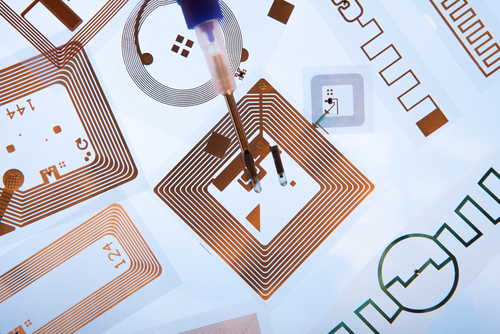 What is RFID Bonding?
What is RFID Bonding?
RFID Bonding refers to either the bonding of RFID tags to items or bonding the chip to the tag. RFID = Radio frequency identification (usually in the form of RFID tags). These consist of a microchip and antenna which give off a frequency which can be detected by a reader. Use of RFID tags is now widespread, they can be found in bank cards, ski passes, library books, security tags, entry fobs, transport cards and ticketing as well as more rugged applications such as vehicle tracking, medical equipment tracking, logistics / inventory management and tool tracking to name a few.
Passive RFID tags do not contain batteries, power is supplied by a reader. A coiled antenna within the tag forms a magnetic field which the tag draws power from. Once powered, radio waves are emitted which are then detectable by the reader and information is then fed back to a computer.
What applications are there for RFID bonding?
There are several applications where adhesives are often used within the RFID bonding industry.

- Bonding the chip or “flip chip” to the tag is normally done with an epoxy adhesive. Sometimes an electrically conductive adhesive is required (so silver-filled adhesive can be used in this instance). Anisotropic adhesive may be required, these are conductive in one axis but offer electrical resistance in another direction.
- Pressure sensitive adhesive is often used on basic RFID tags, particularly those found on consumer goods, library books etc. These appear like stickers with a backing, can be peeled off and then stuck to items. These are quick and practical for items where the label doesn’t need long term durability against harsh conditions.
- RFID tag bonding to item – high strength permanent bonding of RFID tags to equipment, vehicles, tools, medical devices etc. This can be done with several different types of adhesive depending on the application and user preferences: cyanoacrylates – these offer the user a very fast cure in a matter of seconds. Structural acrylic adhesives are also a popular choice, these offer a reasonably fast cure coupled with high peel strength and good environmental resistance. Thirdly, epoxy adhesives, these offer excellent resistance against water, chemicals and high temperature resistant grades can resist autoclaving – making them ideal for bonding RFID chips onto medical equipment.
- RFID tag bonding and encapsulation – this offers the ultimate in environmental resistance and tamper-proofing and will help protect the RFID chip inside.
RFID BONDING

RFID BONDING & ENCAPSULATION

RFISHY offers a wide range of adhesives as well as a custom formulation team to help match the right product for your application.
For further help and advice, please contact RFIDHY.






